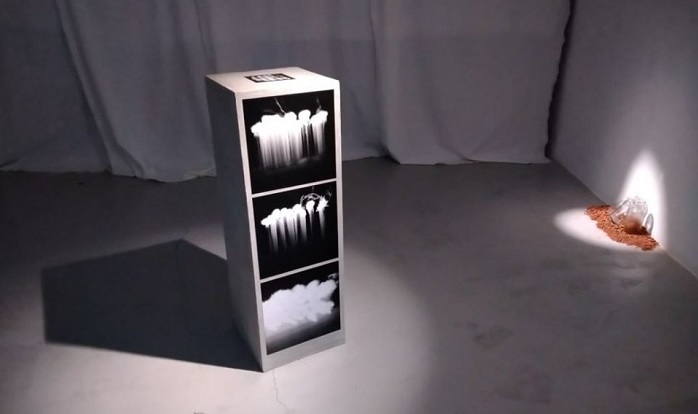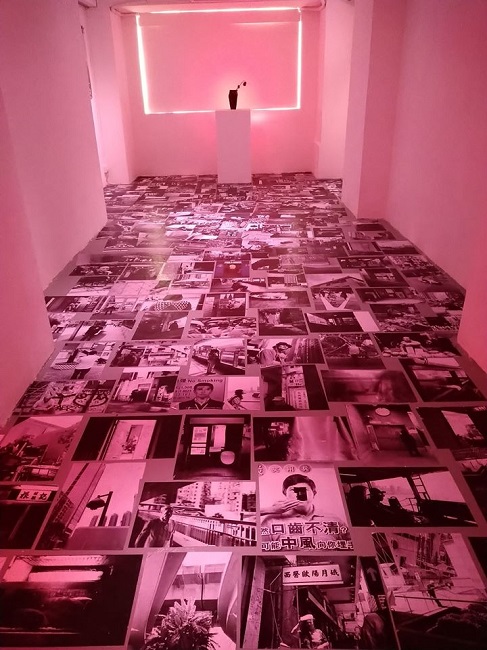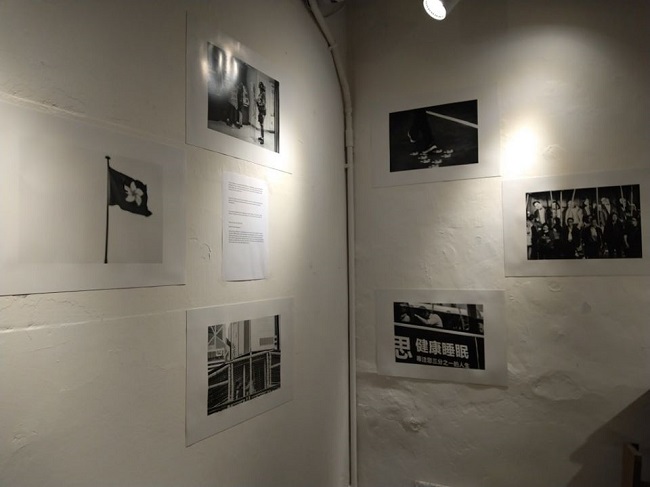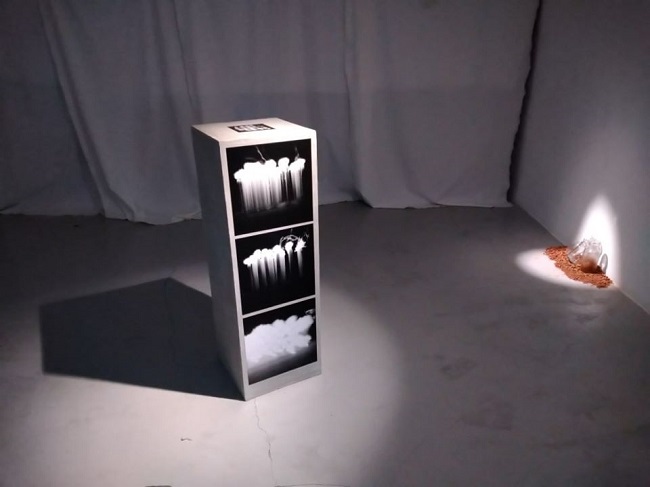藝評
影像超重 —— 談香港國際攝影節2020 | Overwhelming and Overloaded - Hong Kong International Photo Festival 2020
吉暝水
at 2:35pm on 29th June 2020

圖片說明:
岑倩衡的《餘燼與安魂曲——時間站在誰的一邊?》嘗試將 1989 年的六四和 2019 年的抗爭連繫在一起
Caption:
Iris Sham, Time is always on our side – Remnants and Requiem parallels June Fourth Incident in 1989, Beijing with the protest in 2019, Hong Kong
所有照片由作者提供
All photos: Grace Gut
(Please scroll down for English version.)
從大型戶外廣告板到智能手機,影像充斥在日常生活的各個角落。特别在過去的十年,人們日漸沉浸其中,成為新常態,甚至不能自拔。自去年六月起,影像對於香港人來說,意義更為重要,尤其是相片和直播被視為歷史證據。無數無眠的夜晚,大家看著手機放送的影像,跟進社會抗爭的最新動態。影像雖然沉重,但誰願放手?
在如此背景之下,香港國際攝影節(HKIPF)今年 5 月開幕。當大眾高度依靠影像認知現實時,還有多少空間留給「攝影作為藝術」的討論?
受到新冠肺炎疫情影響,已故紀實攝影師羅拔・法蘭 (Robert Fran) 的主題展覽被迫延期,今年HKIPF 遂只剩下衛星展覽及「新一代影像創作者育成計劃」的展覽。這些如期舉行的展覽當中,大約一半以社會運動為題,很多與去年社會抗爭相關。現時政治氣氛日趨緊張,自我審查漸成常態,但HKIPF 仍然在這一年一度的活動中,展出這些很可能被視作「敏感」的作品,不可不算是一種勇氣。
勇氣固然值得嘉許,但不能否認部分項目表現較為粗糙。我承認這評價並不全面——全數28 場展覽,我只去了其中 16 場,而這 16 場裡面確實有不少尚待進一步發展。下文分成三類再作討論。
抓住概念,但闡述不夠完整
有些參展藝術家顯然有話要說,但作品本身不足以自圓其說。以李卓媛《裂像的破口》為例,藝術家為自己 2014 年不在香港、無法親歷雨傘運動而感到遺憾,造成「集體回憶的斷裂」。因此,她運用谷歌地圖上夏慤道的影像,以銀鹽攝影的方式曬印出來,製成作品《裂像的破口》。相片中的影像很暗、很模糊,乍看起來一片黑,黑得有點反光,展場附近街景也映進去。放在彌敦道街頭的報紙檔展示,正好是以 2014 年的夏慤道,對比 2019 年的彌敦道,兩場社運的交疊;報紙檔的書刊與相片,兩種影像的並置交錯。這些對比都能展現出來,但為甚麼要這樣處理,作品中沒有太多提示。黑,在今時今日語境中,意涵幾乎直指抗爭者;但作品中的黑,似乎是指藝術家個人回憶的「破口」,多於社運本身。意涵複雜多樣,但之間又斷裂太多,線索不足,觀眾容易迷失。
岑倩衡的《餘燼與安魂曲——時間站在誰的一邊?》同樣採用對比概念,嘗試將 1989 年的六四和 2019 年的抗爭連繫在一起,並對香港人30 年來風雨不改的堅持予以肯定。 相片作品本身的力量不算很大:左一排蠟燭,右一排催淚彈,影像放在燈箱陳示。我問藝術家,為何選用燈箱?她解釋,燈箱有助影像看起來更加立體。對我來說,燈箱形式強烈,加上旁邊名為《銅鑼灣》的三個小玻璃瓶,裡面裝著的物料,由蠟燭、磚頭到催淚彈灰。玻璃瓶又帶出藥瓶、標本的感覺。展覽整體有種「醫學」的氣氛,但餘燼與安魂又似乎與醫學關係不大。如果沒有錄像作品《念你如昔》直白道出藝術家何以將 1989 和 2019 連上的原因,兩組作品關係顯得稍為薄弱。

李卓媛《裂像的破口》作品在彌敦道的報紙檔上展示
太直白,又變得陳腔濫調
另一些參展藝術家嘗試回應時局,但缺乏獨特的個人見解。就像林健恆的《都市.病》,相片直接地呈現出香港病態一面。他的鏡頭捕捉:守住自動櫃員機使用者的防暴警察、位於垃圾收集站樓上的露宿者之家、貼滿天價樓盤廣告地產舖前的小孩……這些病徵大部分香港人應該早已察覺到,再看林健恆的相片,重新確認問題所在,意義為何?
類似問題同樣可見於曾冠群的《臨時邊界》。藝術家用上粉紅霓虹燈,很搶眼,直接地把一切都「染紅」了,呼應藝術家「呈現岀正逐漸消失的一國兩制,令原有邊界消亡」的本意。相片作品絕大部分不掛於牆上,而是鋪滿地板。曾冠群表明,展示數以百計的照片,提出「對氾濫的沉思」。這點意圖具體地表現出來,同樣非常直接,容易理解。作品容易理解,觀眾明白才有機會扣連關係,互動方能發生。然而,直白到甚麼程度叫做足夠?到甚麼地步就變成陳濫?已知之事,透過他人作品來印證一次,這就是藝術的意義嗎?

曾冠群的《臨時邊界》具體呈現「影像氾濫」

林健恆以《都市.病》為喻,總結香港人荒謬的日常
衝擊太大,偏離主線
上述兩個情況較多出現在新晉藝術家身上,但歷練較多的藝術家亦遇到另一種挑戰——如何繼續一貫的創作路向,而又回應到當今社會?
很多人討論黎雪沁的《With Light》。展場簡單一條發光的燈線勾勒出獅子山輪廓,成為不少人打卡的熱點。然而,藝術家的其他作品幾乎都是「隱藏的」,觀眾要自己用手機的燈,照出一幅幅相片。對比之下,那道「獅子山」的光,好像在一些低調的作品之中忽然高調起來,甚至風頭太大、蓋過其他作品。

黎雪沁的《With Light》大部分作品「隱藏」起來,要打開手機燈才可見到
黃冠華《融合》的情況也差不多。曾經在中國大陸做過攝影記者的他,整合當年拍下來的相片,拼貼出一組作品「香港人眼中的中國」。這組作品本身已很完整、很足夠,但他偏偏只用了展場的一面牆展出這組《融合》之作,另一面牆卻放滿去年在抗爭現場拍下的相片。將兩組頗不一樣的作品放在一起,不易「融合」。
評論這些展覽的時候,我也不是沒有糾結。一方面,我欣賞他們在如此社會氣氛之下,仍然展示可能「敏感」的內容;另一方面,他們想要以藝術回應社會,但跑開了原本的創作線路,我又會感到可惜。過去一年香港發生的事情固然刻骨銘心,藝術家願意用作品紀錄時代體現使命與承擔。然而,記憶太過新鮮。一幀幀超重的影像極有可能尚在消化。或者,我們都不用焦急,毋須強迫自己現在就要用藝術作出回應。就讓這份意志留在心底,慢慢滋長,總有一天會發花結果。
Overwhelming and Overloaded - Hong Kong International Photo Festival 2020
by Grace Gut
Over the last decade, we have been surrounded by images, from outdoor advertisement hoardings to those on personal gadgets. Image overload is so annoying to people. However, imagery has become more important to many Hongkongers since June 2019. Especially photographs, as they represent the evidence of history. On countless nights people have held their mobile phones to follow the latest status of the Hong Kong anti-government protests. Even though many of the images are heavy, people would rather stay updated about what is happening.
Against this background, this year’s Hong Kong International Photo Festival (HKIPF) has become a special and interesting event. When people rely on images to perceive reality, what room is there to further discuss photography as a medium of art? Due to the global coronavirus pandemic, this year’s main exhibition featuring recently deceased documentary photographer Robert Frank was postponed. However, satellite exhibitions and incubation projects continued, echoing the documentary nature of photography.
Almost half of this year’s satellite exhibitions and incubation projects were devoted to exploring aspects of Hong Kong’s current and recent social movements. Given that the political situation is tense and self-censorship has become more prevalent, a photo festival featuring such imagery could be regarded as “sensitive”. However, HKIPF is willing to offer this annual event to showcase these works, a courageous gesture in such difficult times.
Although the intention of the Festival is worthy of appreciation, many participating projects were ‘raw’. This may not be a completely fair comment, as I have not visited all the exhibitions, however, of the 16 exhibitions I have visited (out of a total of 28), many needed further development. In the following examples, I am going to discuss how participating artists try to respond to the society and I evaluate their effectiveness; I highlight three key issues, as follows:
Incompleteness for Improvement
Sharon Lee’s “The Crack of Dawn” and Iris Sham’s “Time is always on our side – Remnants and Requiem” for example, are HKIPF ‘incubator’ exhibitions. Lee regrets her absence during the 2014 Umbrella Movement. The missing collective memory leaves a metaphorical ‘crack’ for her. “The Crack of Dawn” is formed as she tries to display images of Admiralty, which was one of the occupied areas in 2014; and on Nathan Road, a major ‘battlefield’ of the social movement since 2019. Likewise, this exhibition extends onto the street with photographs placed at newsstands all along Nathan Road. The artist explains that this pairing compares and contrasts news images alongside artistic photos. As a viewer, I wish to know why she makes this comparison? Her photographs do not provide enough clues. I can see the contrast, but why? These questions are unanswered.
Sham’s project is also about comparisons. She tries to parallel the Tiananmen massacre of 4 June 1989 in Beijing to Hong Kong’s social movement protests since 2019. In the exhibition, she places two sets of images face-to-face. On one side is the candle symbolizing 4 June candlelight vigils; another is tear-gas canisters and gloves collected last year. These images are displayed in lightboxes. The artist explains that using lightboxes helps to make the subject objects look more three-dimensional. However, the form of the lightboxes is overwhelming. Also, there are some (three-dimensional) glass jars containing material collected from Causeway Bay protests and vigils. They come together forming a strong correlation to science and medicine, but how does it connect the 4 June vigils and social movements in 2019? Again, it is difficult to find the reason within the exhibition. The HKIPF incubator projects allow emerging artists an exhibition opportunity. Experimentation is just one process to success, so, the impression of incompleteness can be expected, but I hope to see further exploration and development in their future exhibitions.

Iris Sham, Time is always on our side – Remnants and Requiem parallels June Fourth Incident in 1989, Beijing with the protest in 2019, Hong Kong

Sharon Lee, The Crack of Dawn showcases at newsstands on Nathan Road
Too Explicit Becomes Kitsch
Incompleteness means the artist is already on track. They have found their own voice, but could articulate in a better and clearer way. However, some artists respond to social topics without personal attachment, which appears to be a bigger issue. Jimmy Lam uses the metaphor of “Urban Disease” to summarize Hong Kong’s current ‘absurd’ everyday situation. He captures riot police standing behind a person using an ATM, a homeless shelter above a refuse collection point, a kid outside a property agency facing an advertisement of the sky-high property prices, etc. These scenes are very familiar to Hongkongers. I guess most viewers would recognize these “symptoms” and would not deny Hong Kong is a socially distorted society. If so, what is the point of highlighting these social issues once again? I expect photography to go beyond a mere representation of reality. At a minimum, a photographer can make a stronger statement based on their observations.
Jimi Tsang’s “Temporal Boundary” is also trapped within these limitations. Tsang has arranged hundreds of photographs on the exhibition floor to demonstrate the flood of images in the digital age. He also casts a red neon light around the exhibition space to visualize Hong Kong’s “dye-red” situation, mirroring the growing influence (using a Cantonese term) under communist China. Both Lam and Tsang’s work are very direct and easy to read, but I do not see any new perspectives on these old topics. Through reinforcing stereotypical perceptions these exhibitions look a bit kitsch. Unlike the state of incompleteness, photographers that have no inspiration is a bigger issue, as the view of the artist is almost absent, or not yet able to suggest a unique perspective, which requires greater effort to break through.

Jimi Tsang, Temporal Boundary demonstrates the image-flood in the digital age

Jimmy Lam uses the metaphor of “Urban Disease” to summarize the ridiculous everyday life of Hongkongers
Distraction from Social Movement
Apart from the above two issues commonly found among the HKIPF incubator projects, the final captioned issue is more sophisticated, and which may also afflict more established artists. I am sympathetic that Hong Kong’s social movement has brought a huge impact on everyone living in the city, including photographers. It is difficult to take away the social influence in the making of art. The challenge is how to strike a balance between those social happenings and their original projects.
The satellite exhibition “With light – We Can Conquer Our Fear” by Lai Suet Sum has aroused much public discussion. The photographer’s spotlight is focused on the use of mobile telephone flash lighting and the outline of a sparkling Lion Rock, as both have been significant visual moments in the recent social movement. Interestingly, the “main dish” of this exhibition is the photographic scenery taken in darkness, which has not received much audience attention. The artist captures the light behind the clouds, visualizing the English saying that, “every cloud has a silver lining”. It could be said that these works are universal. However, the title and the display’s set-up limit the exhibition to a very social and political interpretation.
Another satellite exhibition, Cody Wong’s “Fused” is similar. Originally, Cody consolidates his old photographs previously taken in China, when he was a photojournalist stationed in Beijing. He overlaps different images into a single photograph to demonstrate his impression of the current China. In the exhibition space, he spares one side of the wall to feature the above thematic series, while on the opposite he shows recent Polaroid photographs taken during the protests since 2019.

Lai Suet Sum, With light – We Can Conquer Our Fear, behind the sparkling outline of Lion Rocks
I struggled to review these exhibitions. On the one hand, I appreciate photographers taking the courage to voice out the (possible) “sensitive” political situation; on the other, it is a pity that the social movement distracts so much from their originally intended projects; the ‘issues’ dominating the art. Hong Kong’s protests have been overwhelming, and have been a visual overload. I understand artists are eager to respond to society’s concerns. However, these memories are too fresh, which we are probably still digesting. There is no rush, perhaps. Don’t push yourselves too hard – the pressure is that “I must do something in art NOW”! But, do give time to let it grow in your mind. A seed sowed will blossom one (future) day.
